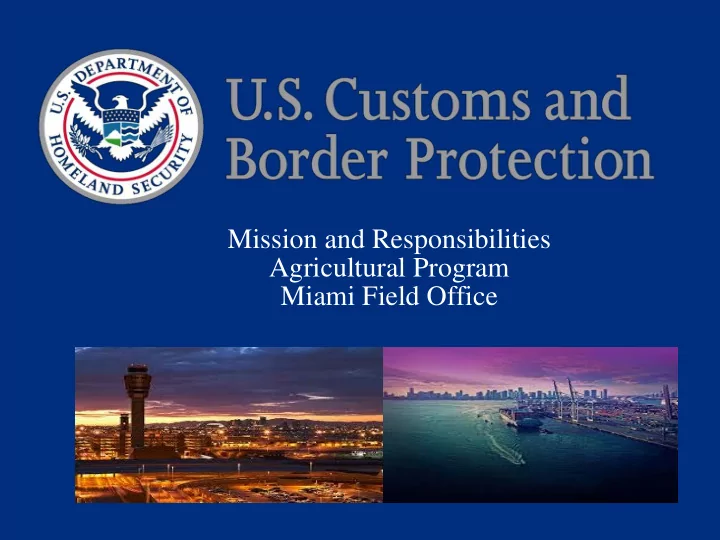

Mission and Responsibilities Agricultural Program Miami Field Office
U.S. Customs and Border Protection (CBP) Miami Field Office Air Operations Sea Operations Abel Serrano Lynn Ramos Branch Chief Chief Agriculture Specialist Agriculture Cargo Operations Agriculture Operations Miami International Airport Miami Seaport 2
Origins of CBP Early beginnings: 1789: First Customs Service Administration 1891: Immigration Inspection Expands 1912: Agriculture Safeguards 1924: Border Patrol Established 1933: 1968 and 1972 3
September 11, 2001 “At 8:46 on the morning of September 11, 2001, the United States became a nation transformed.” 4
November 25, 2002 President George W. Bush signs the Homeland Security Act of 2002 and creates the “DEPARTMENT OF HOMELAND SECURITY” 5
March 1, 2003 U.S. CUSTOMS AND BORDER PROTECTION (CBP) is created as part of the Department of Homeland Security. The U.S. Customs Service is transferred to CBP, along with the U.S. Border Patrol, the U.S. Department of Agriculture, Animal and Plant Health Inspection Service, and inspection function of the U.S. Immigration and Naturalization Service. 6
Origins of CBP Before CBP, security, compliance and facilitation of international travel and trade were conducted by multiple organizations. In March 2003, as a result of the homeland security reorganization, most of the U.S. Customs Service was merged with the border elements of the Immigration and Naturalization Service, including the entire Border Patrol and former INS inspectors, together with border agriculture inspectors, to form U.S Customs and Border Protection, a single, unified border agency for the U.S. 7
U.S. Customs and Border Protection Mission Statement We are the guardians of our nation’s borders. We are America’s frontline. We safeguard the American homeland at and beyond our borders. We protect the American public against terrorists and the instruments of terror. We steadfastly enforce the laws of the United States while fostering our nation’s economic security through lawful international trade and travel. We serve the American public with vigilance, integrity and professionalism . 8
U.S. Customs and Border Protection Mission Overview CBP is one of the world's largest law enforcement organizations. Responsible for securing U.S. borders while facilitating lawful international travel and trade. CBP takes a comprehensive approach to border management and control, combining customs, immigration, border security, and agricultural protection into one coordinated and supportive activity. Responsible for enforcing hundreds of U.S. laws and regulations. 9
U.S. Customs and Border Protection Mission Overview Has a complex mission at ports of entry with broad law enforcement authorities tied to screening all foreign visitors, returning American citizens and imported cargo. CBP provides security and facilitation operations at 328 ports of entry (land, air and sea ports) throughout the country. 10
U.S. Customs and Border Protection Agriculture Mission Overview 11
Origins of CBP's Agricultural Program Agricultural border inspection duties moved from the Department of Agriculture's Animal and Plant Health Inspection Service, known as APHIS, to the Department of Homeland Security and U.S. Customs and Border Protection in March 2003. 1,560 Agricultural Inspectors came on board from the USDA. Today, the agency has deployed more than 2,400 Agriculture Specialists at approximately 182 ports of entry. 12
CBP's Agricultural Program Functions • Some of the USDA functions were transferred to CBP: – Aircraft Inspection (passenger, crew, baggage and cargo) – Vessel Inspection (passenger, crew, baggage and cargo) – Mail Inspection – Collection and submission of pest interceptions for USDA identification – Supervision of cargo destruction, re-exportation and other treatments (cleaning). 13
CBP’s Agricultural Program Mission • To protect agricultural and food products from contamination and/or infestation with plant pests and foreign animal diseases. • CBP facilitate legitimate trade and travel while protecting our Homeland: the American people, plant and animal resources, and the U.S. economy. 14
Agriculture Agriculture is the largest industry and employment sector in the United States. Agriculture accounts for more than $1 trillion in annual income to the U.S. economy. Exotic pests, animal diseases and invasive species have caused $138 billion in economic and environmental losses to the U.S. economy. 15
Protecting Agriculture Millions of pounds of fresh fruits, vegetables, cut flowers, herbs, and other items enter the United States via commercial shipments from other countries every year. Although these items appear to be harmless, there could be hidden threats in that commercial shipment of fresh items that could seriously threaten U.S. agriculture, our natural resources and our economy. 16
Agriculture Specialists Agriculture Specialists and Canine Teams work at key U.S. ports of entry, including international airports, land borders, and international mail facilities, inspecting both commercial cargo and passengers/pedestrians. CBP Agriculture Specialists at U.S. ports of entry and international mail facilities target, detect, intercept, and thereby prevent the entry of these potential threats before they have a chance to do any harm. 17
Agriculture Specialists Must meet strict educational requirements and receive intensive, scientific-based training developed and administered jointly by USDA and CBP. They make sure that imported fresh products are pest-free. 18
Agriculture Specialists Each year, CBP Agriculture Specialists intercept tens of thousands of “actionable pests” – those identified through scientific risk assessment and study as being dangerous to the health and safety of U.S. agricultural resources.
Agriculture Specialists They check containers and trucks for smuggled agricultural products or packaging materials that might contain invasive species that could harm our agriculture and environment. 20
Agriculture Specialists They examine wooden pallets that could hide the larvae of wood-boring insects poised to attack native trees or nursery stock. 21
Agriculture Specialists They work with specialized x-ray machines that detect organic materials. 22
Agriculture Specialists They utilize agricultural canines specifically trained to sniff out meat and plant materials. 23
Questions? 24
Thank you! 25
Recommend
More recommend